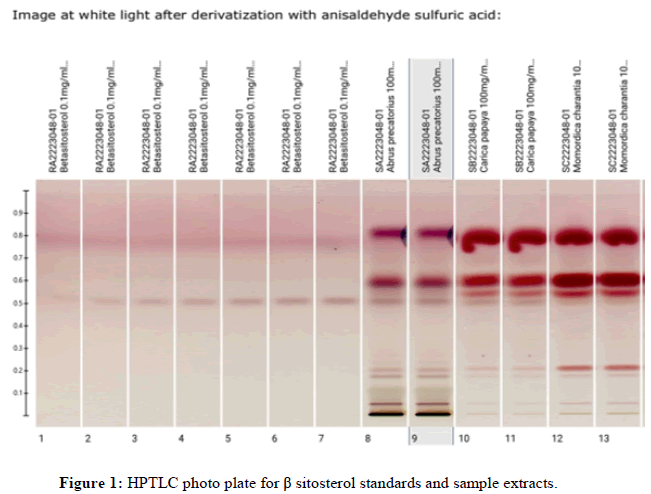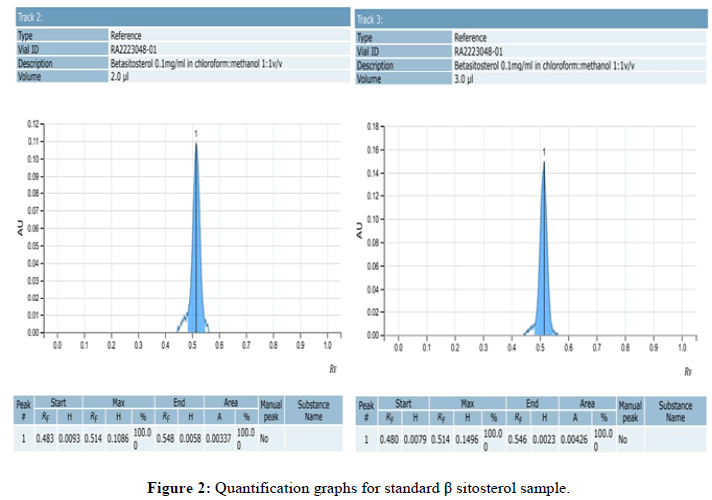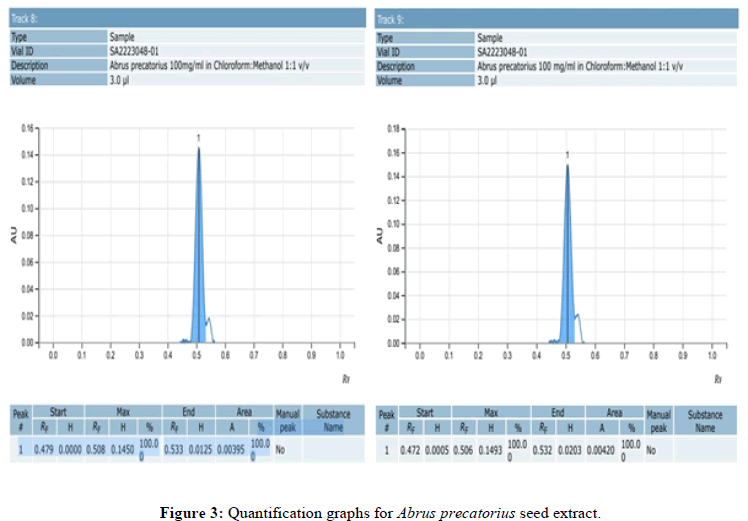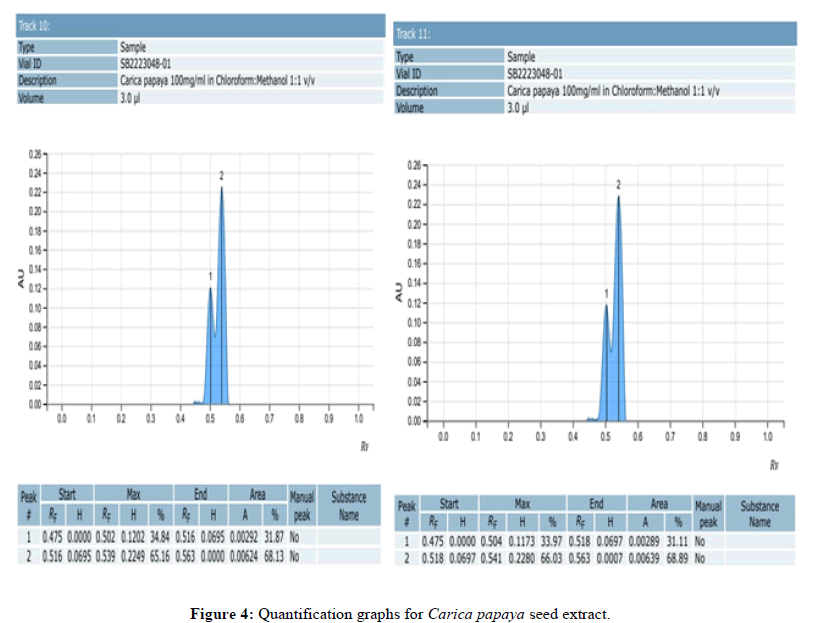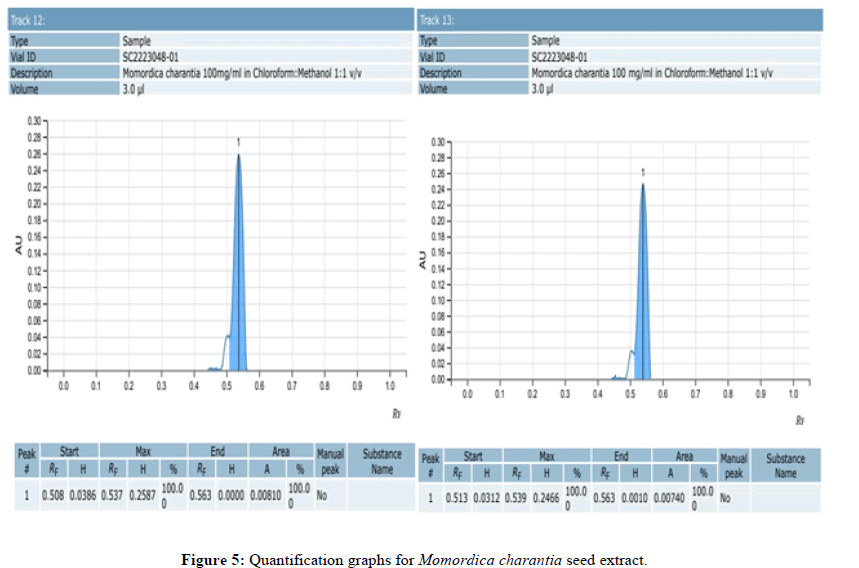Research Article - Der Pharma Chemica ( 2024) Volume 16, Issue 1
β Sitosterol Quantification Using HPTLC in the Crude Seed Extracts for Potential Male Contraception Activity
Manoshree Mondal1 and Devangi Chachad2*2Department of Botany, Jai Hind College, Mumbai, Maharastra, India
Devangi Chachad, Department of Botany, Jai Hind College, Mumbai, Maharastra, India, Email: devangichachad1@gmail.com
Received: 22-Dec-2023, Manuscript No. DPC-23-124189; Editor assigned: 27-Dec-2023, Pre QC No. DPC-23-124189 (PQ); Reviewed: 10-Jan-2024, QC No. DPC-23-124189; Revised: 12-Jan-2024, Manuscript No. DPC-23-124189 (R); Published: 02-Feb-2024, DOI: 10.4172/0975-413X.16.1.178-182
Abstract
β sitosterol is one of the main subcomponents of a group of plant sterols known as phytosterols that are very similar in composition to cholesterol. It is found to be present in many plant tissues like the leaves, roots, fruits and also seeds. These plant sterols are the active components in various pharmacological activities including anti-oxidant, anti-cancer and anti-inflammatory properties. β sitosterol, especially, has been investigated for its anti-fertility effects in the male reproductive system of mice and rats. In the present study, crude seed extracts of Carica papaya, Momordica charantia and Abrus precatorius were studied for their β sitosterol content using HPTLC technique. All of the three plants have been mentioned in several records of traditional medicine and pharmacopoeias for their various pharmacological effects including male anti-fertility activity. The confirmed presence of β sitosterol and its quantification in the crude extracts of these seeds gives us a fair idea of its involvement in their efficacy as agents of male contraception.
Keywords
β sitosterol; HPTLC quantification; Carica papaya; Momordica charantia; Abrus precatorius; Male contraception; Anti-fertility
Introduction
Various plants and their constituents are being used to cure and heal innumerable health disorders and injuries all around the world. This empirical knowledge comes from the plant's defense system, their secondary metabolic pathway, which generates numerous compounds with diverse molecular structures, in far complex combinations to those derived from synthetic products. This further propels our interest in the identification and elucidation of new active principles which have been stated and used in traditional medicine systems since times immemorial. One such compound of interest is β sitosterol [1-5].
Materials and Methods
β sitosterol is a sterol found in almost all plants. It is one of the main subcomponents of a group of plant sterols known as phytosterols that are very similar in composition to cholesterol. These plant sterols are the active ingredients in various oils and margarines used to lower cholesterol. Unlike cholesterol, β sitosterol cannot be converted to testosterone. It also inhibits enzymes aromatase and 5-alpha-reductase which play major roles in testosterone conversion to DHT in androgen dependent tissue. β sitosterol isolated from Barleria prionitis (L.) roots in male albino rats were found to exhibit antifertility effects by decreasing the levels of testosterone, FSH, LH, fructose, sperm motility and sperm density. Therefore, presence of β sitosterol in specific plant parts like the seeds does help us confirm its potential for the induction of anti-fertility effect in the model organisms. Quantification of the levels of β sitosterol in the extracts aids in selection of raw materials and their proportions which can be used in development of a poly herbal male contraceptive formulation in later stages.
This study focuses on the quantification of β sitosterol in the selected crude seed extracts of Carica papaya Linn, Momordica charantia Linn and Abrus precatorius Linn. All of the three plants have been mentioned in several records of traditional medicine and pharmacopoeias for their various pharmacological effects. Identification and estimation of β sitosterol was also done from the individual extracts. Solvents which were found to extract maximum number of phyto constituents and also showed presence of phytosterols from the seed powders during the preliminary analysis were selected [6].
Results and Discussion
β sitosterol was found at the Rf 0.50 in the standards applied and all the extract samples along with formulation after derivatizing the plate with anisaldehyde sulphuric acid reagent (Figure 1).
After identification, quantification of β-sitosterol in the samples was done by a single level calibration method. The base area under the peak was calculated and the graphs obtained were used for the calculation (Figures 1-5). The final concentrations of β-sitosterol found in Carica papaya extract, Momordica charantia extract and Abrus precatorius extract are mentioned in Table 1.
| Sr. no | Sample name | Amount of β sitosterol detected in % |
|---|---|---|
| 1 | Abrus precatorius | 0.08 |
| 2 | Carica papaya | 0.03 |
| 3 | Momordica charantia | 0.004 |
Table 1: Final quantification of β sitosterol in seed extracts (%).
Oral administration of C. papaya seed extracts on sexually mature male Wistar albino rats have been found to exhibit pronounced male anti-fertility effect in male rats with gradual degeneration of sertoli and leydig cells along with hypertrophy of pituitary gonadotrophs. It also showed clearance in epididymal tubules, disorganisation of seminiferous tubules, reduced sperm cell counts along with suppression of cauda epididymal sperm motility. Oral administration of M. charantia seed extract was found to exhibit significant reduction in sperm density and motility and also in the diameters of seminiferous tubules and epididymis. It also induced reduction in sperm viability and motility along with increase in the weight of reproductive organs i.e., androgenic effects and promises to be an excellent contraceptive agent. Oral administration of A. precatorius seeds extracts was found to reduce sperm motility, serum testosterone levels, metabolism and altered sperm morphology in epididymis of sexually mature male albino rats. It is found to induce absolute but reversible infertility by suppression of sperm motility in Cauda epididymis and absolute reduction in spermatogenesis and fertility, marked atrophy in seminiferous tubules and reduction in pregnancy rate in albino rats [7-10].
Thus, presence of β sitosterol and its quantification in the crude extracts of these seeds gives us a fair idea of its involvement in their efficacy as agents of male contraception. Classic marker molecules like β sitosterol serve as an important active constituent and should be further investigated for its exact mode of action and physiochemical kinetics. It also opens up the avenue to formulate a polyherbal combination that will result in increased and faster efficacy which can go ahead for advanced animal trials.
The collection of the fruits and pods of the plant specimens were done from in and around Mumbai and then authenticated from Blatter Herbarium, Mumbai. The seeds were separated from their respective fruit pulp and pods and shade dried for 4 days. They were then powdered using a mixer grinder and stored in airtight glass containers [11].
Crude extracts were prepared using 1 g of the dried powder of the seeds. C. papaya was extracted in 50 ml of chloroform by cold maceration for 24 hours and then subjected to rotary evaporator for total removal of solvent. An oily thick brown paste was obtained which was used for further analysis. M. charantia was extracted using 50 ml of benzene by cold maceration for 24 hours and then subjected to rotary evaporator for removal of solvent. A sticky semi solid dark brown paste was obtained which was used for further analysis. A. precatorius was extracted in 50 ml of ethanol for 24 hours and then subjected to a rotary evaporator for total removal of solvent. A blackish brown sticky powder was obtained which was used for further analysis [12-15].
The loading sample was prepared after total removal of solvent. Chloroform extract of C. papaya, Benzene extract of M. charantia and Ethanolic extract of A. precatorius were weighed and individual loading samples were prepared by addition of a diluent i.e., chloroform: Methanol (1:1) in the concentration of 10 mg/ml. High-performance thin layer chromatography technique for crude extract analysis and identification and estimation of β sitosterol content was performed according to Upton R. 2000. Both, qualitative and quantitative, analysis were carried out at Anchrome Enterprises P. Ltd., Mulund East and Mumbai.
For HPTLC analysis, 20 cm × 20 cm TLC silica gel glass plate 5715 was used as the stationary phase, 35 ml toluene: Ethyl acetate: Formic acid v/v/v 15:4.5:1.5 was used as the mobile phase and 10% methanolic sulphuric acid was used as the derivatizing agent.
Conclusion
Carica papaya, Momordica charantia and Abrus precatorius are popular plants that have been explored for their immense pharmacological potential since ages. The leaves and fruits of C. papaya and M. charantia and leaves of A. precatorius are eaten raw and in various food preparations. These natural drugs are biochemically complex, contain several active constituents and have important pharmaceutical and industrial applications. Only the seeds of these plants are found to be under-utilized when it comes to drug discovery or conventional commercialization. Thus, this study is an attempt to harness the biochemical constitution and easy availability of the seeds of these commonly found plants into the development of a drug that targets ‘male contraception’ which has very limited options available.
Acknowledgement
The authors are grateful to the Blatter herbarium, St. Xavier’s College, Mumbai for helping us with the authentication of the plant samples. We are also thankful to the entire staff at Anchrome enterprise Pvt. Ltd. Mulund (E), Mumbai for lending their knowledge and expertise in the HPTLC analysis.
Declaration of Interest Statement
Authors declare that there is no conflict of interest.
References
- Jerald SE, Pandey A, Bigoniya P, et al. J Appl Pharm. 2012; 4(4): P. 35-37.
- Lohiya NK, Goyal RB. Indian J Exp Biol. 1992; 30(11): p. 1051-1055.
[Google Scholar] [PubMed]
- Naseem MZ, Patil SR, Patil SR, et al. J Ethnopharmacol. 1998; 61(1): 9-16.
[Crossref] [Google Scholar] [PubMed]
- Patil SA, Patil SB. Int J Morphol. 2011; 29(4): p. 1212-1218.
[Crossref] [Google Scholar] [PubMed]
- Rakel D, Miszczyk J, Przydacz M, et al. Cancer Manag R. 2021: 17(5): p. 4291-4298.
[Crossref] [Google Scholar] [PubMed]
- Rao MV. Acta Eur Fertil. 1987; 18(3): p. 217-220.
[Google Scholar] [PubMed]
- Shubhangi S, Verma A, Das PK, et al. Int J Sci Re. 2018; 7(4): p. 57-58.
- Singh KA, Gupta RS. Int J Pharm Pharm Sci. 2016; 8(5): p. 88-96.
- Sinha R. J Ethnopharmaco. 1990; 28(2): p. 173-181.
[Crossref] [Google Scholar] [PubMed]
- Talukder S, Sarker S, Hossain MA, et al. Pak Vet J. 2014; 34(1): p. 18-23.
- Tumkiratiwong P, Ploypattarapinyo R, Pongchairerk U, et al. Iran J Reprod Med. 2014; 12(10): p. 695-696.
[Google Scholar] [PubMed]
- Udoh FV, Udoh PB, Umoh EE. Pharm Biol. 2005; 43(6): p. 563-567.
- Udoh P, Kehinde A. Phytother Res. 1999; 13(3): p. 226-228.
[Crossref] [Google Scholar] [PubMed]
- Udoh P, Essien I, Udoh F. Phytother Res. 2005; 19(12): p.1065-1068.
[Crossref] [Google Scholar] [PubMed]
- Upton R. J Ethnopharmacol. 2000; 17(8): p.100-110.

